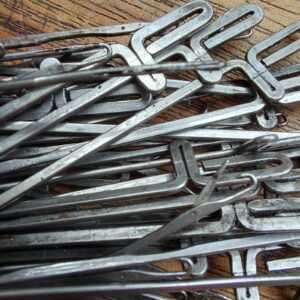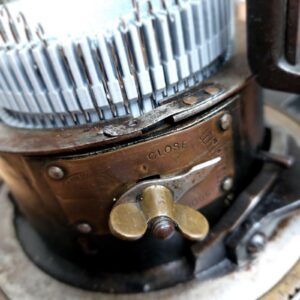After the stocking machine adventures at the stocking machine conference, a few things have happened and learned that we would like to share.
This circular knitting machine was made for Higham Knitting Machine Machine Co of Newton Heath Manchester by a sewing machine manufacturing company, Shepherd, Rothwell, and Hough of Oldham in approximately 1890.
The Higham brothers based their design on 1870s circular stocking machines made by manufacturers like Griswold & Hainsworth of London and Creelman of Canada.
Higham knitting machines have an unusual row counting arrangement where a brass gear ring rotates around the cylinder and allow up to 450 rows to be counted.
This particular machine is peculiar because it was intended to knit using very fine yarn to make samples that approximated to woven cloth, so it used a very high count of 112 very gauge fine needles in an unusually narrow cylinder. Most of the original needles are too damaged to knit today.
Ordinary circular stocking machines have a left and right cam that allows knitting forward (for the tubular parts – leg and the foot) and to knit back and forth (for the heel and toe). This machine was intended to knit samples so has only one cam and only knits forwards.
When this machine was made many different thicknesses of needles and cylinder diameters were available to allow everything from coarse fisherman’s socks to fine silk stockings or baby’s socks to be knitted.

Very fine needles are no longer available today in a similar length so a knitting machine enthusiast made a reproduction cylinder to allow thicker needles to be used. This cylinder was 3D printed in an organic filament called PLA and took about 20 hours to print out on a Flashforge Adventurer 3D printer.
The cylinder was designed and printed by Eric Sharp ([email protected]) using Computer Aided Design, CAD. The real work is in adjusting the design to allow it to work as a 3D print design which is mechanically different from the original process of casting a steel cylinder blank and then cutting out the needle slots.


Unlike the original steel cylinder, this reproduction will eventually bio-degrade.
With all this new technology we have managed to bring the stocking machine to life again and create stocking samples again after many years.
Further exhibits of circular knitting machines are displayed at https://frameworkknittersmuseum.org.uk/
More information about circular knitting machines is available from the Facebook group Vintage Krankers.
Our thanks go to the amazing Eric and Mary and the staff and volunteers and experts at the Framework Knitters Museum, Nottinghamshire
Tags
General Museum & Archive Arts & Culture
